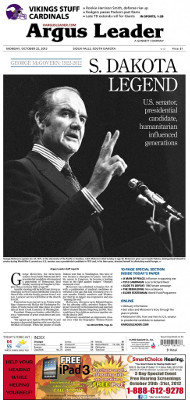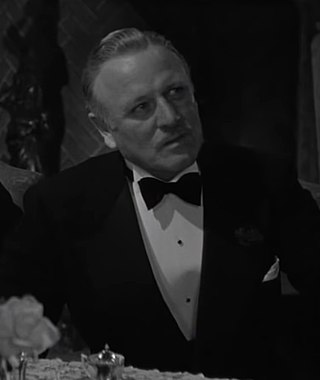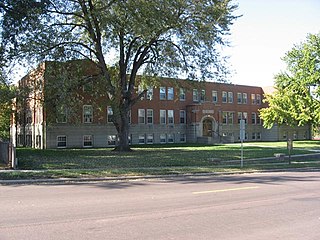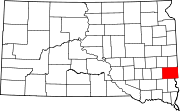
Interstate 229 (I-229) is an auxiliary Interstate Highway located entirely within Sioux Falls, South Dakota, United States. It runs for approximately 11 miles (18 km) around the southern and eastern sides of the city, providing a bypass route and connecting I-29 and I-90. The freeway is generally four-to-six lanes wide and follows the Big Sioux River through parts of the city. I-229 also has a business route that provides access to downtown Sioux Falls from the freeway.

KELO-TV is a television station in Sioux Falls, South Dakota, United States, affiliated with CBS, MyNetworkTV, and The CW Plus. The station is owned by Nexstar Media Group, and maintains studios on Phillips Avenue in downtown Sioux Falls; its transmitter is located near Rowena, South Dakota. KELO-TV is broadcast by three high-power semi-satellites—KDLO-TV in Florence, KPLO-TV in Reliance, and KCLO-TV in Rapid City. These transmitters and others, together branded as the KELOLAND Media Group, broadcast KELO programs to all of South Dakota, southwestern Minnesota, and northwestern Iowa, an area the station calls "KELOLAND".

The Argus Leader is the daily newspaper of Sioux Falls, South Dakota. It is the largest newspaper by total circulation in South Dakota.

KDLT-TV is a television station in Sioux Falls, South Dakota, United States, affiliated with NBC and Fox. It is owned by Gray Television alongside ABC affiliate KSFY-TV. Both stations share studios in Courthouse Square on 1st Avenue South in Sioux Falls, while KDLT-TV's transmitter is located southeast of the city near Rowena.

Pierre Frank Watkin was an American character actor best known for playing distinguished authority figures throughout the Golden Age of Hollywood. He is best remembered for his roles of Mr. Skinner the bank president in The Bank Dick (1940); Lou Gehrig's father-in-law Mr. Twitchell in Pride of the Yankees (1942); and the first actor to portray Perry White in the Superman serials Superman (1948) and Atom Man vs. Superman (1950).

The Summit League Men's Basketball Player of the Year is an annual award given to the most outstanding men's basketball player in the Summit League. The award was first given following the 1982–83 season. Two players, Caleb Green of Oral Roberts and Mike Daum of South Dakota State, have each won the award three times. Five other players have won the award twice: Jon Collins of Eastern Illinois, Tony Bennett of Green Bay, Bryce Drew of Valparaiso, Keith Benson of Oakland, and Max Abmas of Oral Roberts.
Joel A. Swisher was an American college football coach and athletics administrator. He served as the head football coach at Dakota State University (1973–1976), Augustana College in Sioux Falls, South Dakota (1977–1980), Adams State College (1982–1983), and Jamestown College (1992–1994), compiling a career college football head coaching record of 65–55–4. Swisher was also the athletic director at Dakota State from 1974 to 1977.
Strool is a ghost town in Perkins County, in the U.S. state of South Dakota. Founded by homesteader Benjamin Strool in 1908, Strool was noted for its thriving culture and baseball team, Jewish community, and practice of renting land rather than selling it.
The 2017 NCAA Division II football rankings are from the American Football Coaches Association (AFCA). This is for the 2017 season.
The 1902 South Dakota Coyotes football team was an American football team that represented the University of South Dakota as an independent during the 1902 college football season. In its first season under head coach Arthur H. Whittemore, the team compiled a 9–0 record, shut out every opponent, and outscored them by a total of 204to 0.
The 1915 South Dakota State football team was an American football team that represented South Dakota State University as an independent during the 1915 college football season. In its fourth season under head coach Harry W. Ewing, the team compiled a 5–1–1 record and outscored opponents by a total of 163 to 7.
The 1915 South Dakota Coyotes football team represented the University of South Dakota during the 1915 college football season. In Ion Cortright's second and final season at South Dakota, the Coyotes compiled a 4–2–2 record and outscored their opponents 86 to 39, not allowing a single point in their final four contests.
The 1927 South Dakota State Jackrabbits football team was an American football team that represented South Dakota State College in the North Central Conference (NCC) during the 1927 college football season. In its ninth season under head coach Charles A. West, the team compiled a 5–3–1 record and outscored opponents by a total of 189 to 89.
The 1930 South Dakota State Jackrabbits football team was an American football team that represented South Dakota State University in the North Central Conference (NCC) during the 1930 college football season. In its third season under head coach Cy Kasper, the team compiled a 2–6–1 record and was outscored by a total of 197 to 48.
The 1955 South Dakota Coyotes football team was an American football team that represented the University of South Dakota as a member of the North Central Conference (NCC) during the 1955 college football season. In their 17th season under head coach Harry Gamage, the Coyotes compiled a 4–4 record, tied for fifth place out of seven teams in the NCC, and outscored opponents by a total of 191 to 151. They played their home games at Inman Field in Vermillion, South Dakota.
The 1956 South Dakota Coyotes football team was an American football team that represented the University of South Dakota as a member of the North Central Conference (NCC) during the 1956 NCAA College Division football season. In their first season under head coach Ralph Stewart, the Coyotes compiled a 4–4 record, tied for second place out of seven teams in the NCC, and were outscored by a total of 146 to 140. They played their home games at Inman Field in Vermillion, South Dakota.
The 1955 North Dakota Fighting Sioux football team, also known as the Nodaks, was an American football team that represented the University of North Dakota in the North Central Conference (NCC) during the 1955 college football season. In its sixth year under head coach Frank Zazula, the team compiled a 6–3 record, tied for fourth place out of seven teams in the NCC, and outscored opponents by a total of 183 to 86. The team played its home games at Memorial Stadium in Grand Forks, North Dakota.
The 1977 South Dakota Coyotes football team represented the University of South Dakota in the 1977 NCAA Division II football season as a member of the North Central Conference (NCC). Led by third-year coach Beanie Cooper, the Coyotes compiled an overall record of 4–7 and a mark of 2–4–1 in conference play, tying for sixth place in the NCC. The team played two games against Nebraska–Omaha in order to save money on travel; each game counted as a half-game in the conference standings.

The Presentation Children's Home is a historic building at 701 South Western Avenue in Sioux Falls, South Dakota. Built to replace an earlier orphanage in Turton that burned down, it functioned not only as an orphanage—one of the few in South Dakota—but also as a school from its opening in 1940 to its closure in 1966. It was added to the National Register of Historic Places in 1993.
KUSD was a non-commercial educational radio station in Vermillion, South Dakota, United States, licensed to the University of South Dakota (USD) from 1922 until 1992. It was deleted two years later after the university decided not to replace a transmission tower that had fallen and shuttered the station. At the time of its deletion, KUSD was the oldest broadcasting station in the state of South Dakota; it was the predecessor to the present radio service of South Dakota Public Broadcasting.








